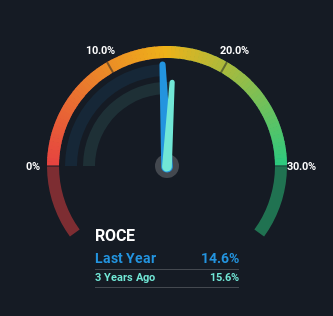Alimentation Couche-Tard's (TSE:ATD) Returns Have Hit A Wall
If we want to find a potential multi-bagger, often there are underlying trends that can provide clues. Ideally, a business will show two trends; firstly a growing return on capital employed (ROCE) and secondly, an increasing amount of capital employed. Put simply, these types of businesses are compounding machines, meaning they are continually reinvesting their earnings at ever-higher rates of return. That's why when we briefly looked at Alimentation Couche-Tard's (TSE:ATD) ROCE trend, we were pretty happy with what we saw.
Return On Capital Employed (ROCE): What Is It?
If you haven't worked with ROCE before, it measures the 'return' (pre-tax profit) a company generates from capital employed in its business. The formula for this calculation on Alimentation Couche-Tard is:
Return on Capital Employed = Earnings Before Interest and Tax (EBIT) ÷ (Total Assets - Current Liabilities)
0.15 = US$4.1b ÷ (US$36b - US$8.2b) (Based on the trailing twelve months to February 2024).
So, Alimentation Couche-Tard has an ROCE of 15%. On its own, that's a standard return, however it's much better than the 12% generated by the Consumer Retailing industry.
View our latest analysis for Alimentation Couche-Tard
Above you can see how the current ROCE for Alimentation Couche-Tard compares to its prior returns on capital, but there's only so much you can tell from the past. If you're interested, you can view the analysts predictions in our free analyst report for Alimentation Couche-Tard .
What Can We Tell From Alimentation Couche-Tard's ROCE Trend?
The trend of ROCE doesn't stand out much, but returns on a whole are decent. Over the past five years, ROCE has remained relatively flat at around 15% and the business has deployed 62% more capital into its operations. 15% is a pretty standard return, and it provides some comfort knowing that Alimentation Couche-Tard has consistently earned this amount. Over long periods of time, returns like these might not be too exciting, but with consistency they can pay off in terms of share price returns.
What We Can Learn From Alimentation Couche-Tard's ROCE
To sum it up, Alimentation Couche-Tard has simply been reinvesting capital steadily, at those decent rates of return. And the stock has followed suit returning a meaningful 100% to shareholders over the last five years. So while the positive underlying trends may be accounted for by investors, we still think this stock is worth looking into further.
Alimentation Couche-Tard does have some risks though, and we've spotted 1 warning sign for Alimentation Couche-Tard that you might be interested in.
For those who like to invest in solid companies, check out this free list of companies with solid balance sheets and high returns on equity.
Have feedback on this article? Concerned about the content? Get in touch with us directly. Alternatively, email editorial-team (at) simplywallst.com.
This article by Simply Wall St is general in nature. We provide commentary based on historical data and analyst forecasts only using an unbiased methodology and our articles are not intended to be financial advice. It does not constitute a recommendation to buy or sell any stock, and does not take account of your objectives, or your financial situation. We aim to bring you long-term focused analysis driven by fundamental data. Note that our analysis may not factor in the latest price-sensitive company announcements or qualitative material. Simply Wall St has no position in any stocks mentioned.

 Yahoo Finance
Yahoo Finance 
